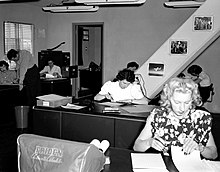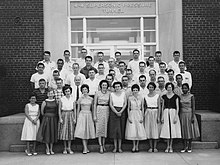Computer (occupation)
"[2] Teams of people, often women from the late nineteenth century onwards, were used to undertake long and often tedious calculations; the work was divided so that this could be done in parallel.Before he died in 1617, John Napier suggested ways by which "the learned, who perchance may have plenty of pupils and computers" might construct an improved logarithm table.[4] Human computers continued plotting the future movements of astronomical objects to create celestial tables for almanacs in the late 1760s.[5] The computers working on the Nautical Almanac for the British Admiralty included William Wales, Israel Lyons and Richard Dunthorne.[8] Women were generally excluded, with some exceptions such as Mary Edwards who worked from the 1780s to 1815 as one of thirty-five computers for the British Nautical Almanac used for navigation at sea.[15] The Signal Corps used a small computing staff that processed data that had to be collected quickly and finished in "intensive two-hour shifts".[20] Many of the women astronomers from this era were computers with possibly the best-known being Florence Cushman, Henrietta Swan Leavitt, and Annie Jump Cannon, who worked with Pickering from 1888, 1893, and 1896 respectively.In 1893, Francis Galton created the Committee for Conducting Statistical Inquiries into the Measurable Characteristics of Plants and Animals which reported to the Royal Society.The computers, often educated middle class women whom society deemed it unseemly to engage in the professions or go out to work, would receive and send back packets of calculations by post.[32] A visionary application to meteorology can be found in the scientific work of Lewis Fry Richardson who, in 1922, estimated that 64,000 humans could forecast the weather for the whole globe by solving the attending differential primitive equations numerically."[35] This would happen again during World War II, as more men joined the fight, college educated women were left to fill their positions.[36] In the Manhattan Project, human computers working with a variety of mechanical aids assisted numerical studies of the complex formulas related to nuclear fission.Margot Lee Shetterly's biographical book, Hidden Figures (made into a movie of the same name in 2016), depicts African-American women who served as human computers at NASA in support of the Friendship 7, the first American crewed mission into Earth orbit.



Shakuntala DeviMental calculatorhuman-based computationcalculationscalculatorsAlan Turingmental arithmeticmental calculatorsAstronomersRenaissancemathematicianspositions of planetsJohannes KeplerJohn Napierlogarithm tableAlexis Claude ClairautHalley's CometJoseph LalandeNicole-Reine LepautealmanacsNautical AlmanacWilliam WalesIsrael LyonsRichard DunthorneNevil MaskelyneMary EdwardsMaria MitchellRoyal Greenwich ObservatoryGeorge AirySignal CorpsUS NavySmithsonian meteorological projectEdward Charles PickeringHarvard ComputersAnna WinlockHarvard ObservatoryFlorence CushmanHenrietta Swan LeavittAnnie Jump CannonMina Flemingspectral linesElizabeth WilliamsLowell ObservatoryFrancis GaltonRoyal SocietyW.F. Raphael WeldonAugust Leopold CrelleKarl PearsonUniversity of LondonAlice Leehistogramschi-squaredBeatriceFrances Cave-Brown-Cavemathematical tablemathematical tablestrigonometrylogarithmsmathematicianpiece workAfsluitdijkZuiderzeeNetherlandsHendrik LorentzLewis Fry Richardsonprimitive equationsWorld War IWorld War IIGeorge Washington Universityactuarylife tablesManhattan Projectnuclear fissionIowa State CollegeBenjamin WoodIndiana UniversityCowles CommissionNational Research CouncilNational Advisory Committee for Aeronauticsoscillographslide rulesMargot Lee ShetterlyHidden Figuresmovie of the same nameFriendship 7Dorothy VaughanLangley Research CenterWest Area ComputersCongressional Gold MedalExplorer 1computer programmersUniversity of PennsylvaniaKay McNultyBetty SnyderMarlyn WescoffRuth LichtermanBetty Jean JenningsFran BilasDifference engineList of obsolete occupationsMathematical Tables ProjectWorks Progress AdministrationMentatWomen in computingScientific Americanarchive.todayCroarken, MaryThe History of Mathematical Tables: From Sumer to SpreadsheetsOxford University PressCampbell-Kelly, MartinBibcodePhilosophical Society of WashingtonPrinceton University PressHayles, Katherine N.Shetterly, Margot LeeHidden Figures: The Story of the African-American Women Who Helped Win the Space RaceWilliam Morrow and Company"Computing machinery and intelligence"Wayback Machine